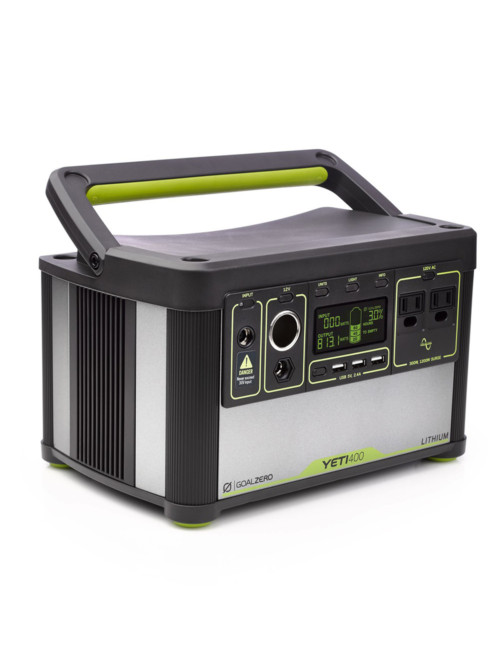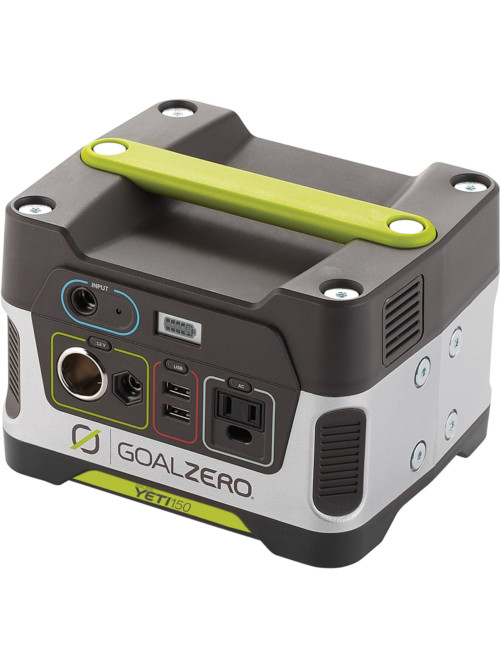- Q: What type of battery is in the Yeti 400?
- A: The Yeti 400 uses a 12V, 33Ah sealed lead-acit battery (AGM), and similar to what is found in your car. Here are some basic facts about AGM batteries:*AGM batteries should be kept full at all times.*AGM batteries last longer if you do not drain them completely. This stems from the “battery memory myth” in old rechargeable batteries.
- Q: How do I know if my Yeti 400 is charged?
- A: To check the charge level of the Yeti 400, refer to the LCD Battery Display. When lit up, you’ll see a battery outline with 5 segments, indicating the current charge level. You can turn on the Battery Display by pushing one of the power buttons above each output port. It is ok to use your Yeti 400 even when it’s not fully charged.
- Q: My Yeti 400 is beeping, what does that mean?
- A: Plug your Yeti 400 into a power source, like a solar panel or outlet, as soon as possible. This chirping is to alert you that your Yeti 400’s battery is low and needs to be charged.
- Q: Can I take my Yeti 400 on a plane?
- A: You sure can, although it is a bit heavy. The Yeti 400 contains an advanced, sealed lead-acid battery that is completely safe to bring along on your flight. Bring along your user manual to show the type of battery inside.
- Q: Is the battery inside my Yeti 400 replaceable?
- A: Yes. Your Yeti 400 depends on an advanced lead-acid battery to power your gear, and like all other batteries, one day it will make the journey to the battery graveyard. Lucky for you, the Yeti 400’s battery is replaceable.
- Q: What do the different display options mean?
- A: Your Yeti 400’s LCD display is an advanced feature designed to help you better understand power and monitor your consumption. In Input side reflects the amount of power your Yeti 400 is receiving while it’s charging. The Output side indicates the amount of power the devices you have plugged in are pulling out of the Yeti 400 – in the form of Amps, Volts, Watts, Amp Hours and Watt Hours.You can use the numbers displayed in Watts to estimate runtimes. For example, if you have a light plugged in that is pulling 100W, you can estimate the Yeti 400 will run the light for about 4 hours (Yeti Wh/Device W = runtime in hours; 400/100 = 4 hours).Watt Hours (Wh) and Amp Hours (Ah) represent the amount of power being pulled per hour. This number continues to accumulate with each use of your Yeti and can be manually reset whenever desired.
|
- Q: Can I power devices from the Anderson Power Pole ports on the side of the Yeti 400?
- A: No. There is no under-voltage protection built into the Anderson PowerPole ports on the side of the Yeti 400, meaning if you try to power devices from these ports you could damage the battery. These ports are meant for chaining other Yeti 400’s or Extreme 350’s for longer runtimes.
- Q: What does a pure-sine wave inverter mean?
- A: When it comes to power, you might have heard the letters DC and AC thrown around. DC stands for Direct Current, and is the only type of power that can be stored in a battery. AC stands for Alternating Current, which is the type of power your devices use when they’re plugged into the wall. An inverter is required to change DC output to AC output and requires a small amount of power for the change. You can see this by turning on the AC port and looking at the output on the LCD display.A pure-sine wave inverter, like the one found in your Yeti 400, produces an output that is exactly the same as supplied by an AC wall plug in your house. Although integrating a pure-sine wave inverter takes more components, it produces power output that makes it compatible with almost all AC electric devices you use in your house.So in the end, the pure-sine wave inverter allows your Yeti 400 to safely power almost everything under 400 Watts in your house that you would normally plug into the wall.
- Q: How do I know if my device with work with the Yeti 400?
- A: First, you’ll need to determine the amount of power your device requires. This may require some research on you end, a good online search or reading the user guide for your device should suffice. To be compatible with the Yeti 400, you should use devices that require less than 300W.Second, you will need to check the capacity for the individual output ports. For example, the AC port is monitored by an inverter that allows for 300W of continuous power. This means if your device is pulling more than 300W for an extended period of time, the Yeti 400’s inverter will shut off.Once you know your device is compatible, you’ll want to determine how long you’ll be able to power your gear from the Yeti 400.
- Q: How long will the Yeti 400 run my device?
- A: All Goal Zero rechargers have numbers in their name. These numbers refer to the Watt Hours (Wh), or the amount of energy that can be stored in each battery, and can help estimate how long your gear will run from each recharger. For example, a 400Wh battery should run a 100W light for 4 hours (400/100=4). If your gear falls within the 400Wh capacity of the Yeti 400, you’ll want to check the restrictions on each of the output ports.
|






